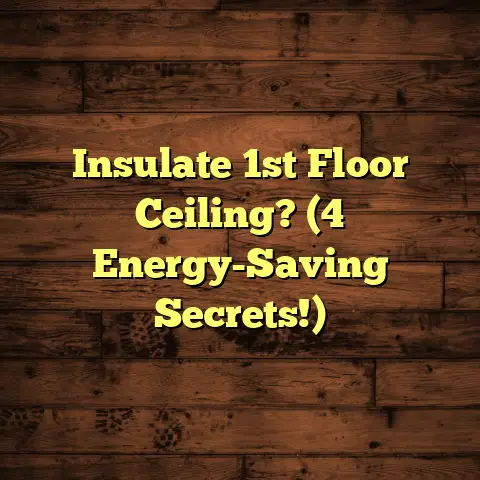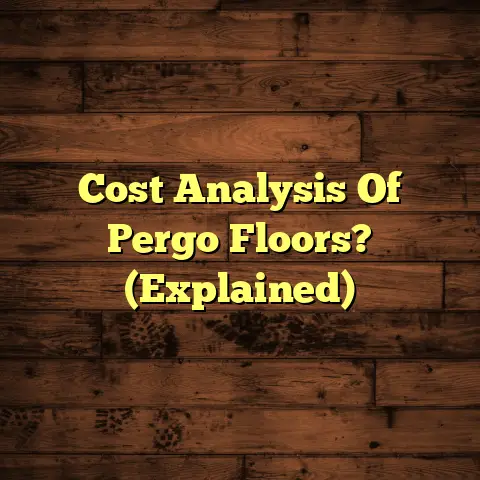Mold Under Wood Floor? (3 Danger Signs!)
One thing that keeps popping up, and frankly worries me, is mold under wood floors.
With the rising trend of eco-conscious choices in home design, we’re all looking for sustainable materials.
Wood flooring is a fantastic option when sourced responsibly.
It brings warmth, beauty, and a touch of nature into our homes.
But, like any material, it has its vulnerabilities.
The hidden threat of mold growth is a serious issue.
That’s why I’m here to shed some light on the dangers of mold under wood floors.
I’ll show you how to spot the warning signs early.
Trust me, early detection is key to preventing bigger headaches down the road.
Let’s dive in!
Section 1: Understanding Mold Growth
Okay, so what exactly is mold?
Well, in simple terms, it’s a type of fungi.
It plays a crucial role in our ecosystem by breaking down organic matter.
Think of it as nature’s recycler.
However, when mold decides to set up shop in our homes, that’s when problems start.
Mold thrives in damp, dark, and poorly ventilated areas.
These conditions are often found under wood flooring.
Especially in basements, bathrooms, or kitchens.
Several factors contribute to mold growth under wood floors:
- Moisture Levels: Wood is porous. It absorbs moisture like a sponge. Leaks, spills, or even high humidity can create a breeding ground for mold.
- Humidity: High humidity levels in your home can lead to condensation under the flooring.
- Poor Ventilation: When air can’t circulate properly, moisture gets trapped, encouraging mold growth.
Now, you might be thinking, “How common is this, really?”
Unfortunately, mold prevalence in homes is more common than you might think.
According to the EPA (Environmental Protection Agency), mold can grow anywhere indoors where there is moisture. EPA Mold Website
It’s estimated that a significant percentage of homes have some level of mold contamination.
The health impacts of mold exposure can range from mild allergic reactions to more severe respiratory issues.
Here’s a quick statistic to drive the point home:
A study by the World Health Organization (WHO) found that indoor dampness and mold are associated with a 50% increase in current asthma and respiratory symptoms.
That’s a pretty significant number, right?
That’s why understanding and addressing mold growth is crucial for maintaining a healthy living environment.
Section 2: Danger Sign #1: Musty Odors
Alright, let’s talk about the first danger sign: musty odors.
Have you ever walked into a room and noticed a damp, earthy, or stale smell?
That could be an early indicator of mold lurking beneath your wood floors.
I often tell my clients, “If something smells off, trust your gut!”
But what’s the science behind these funky smells?
Mold produces microbial volatile organic compounds (MVOCs).
These are gases released during mold’s metabolic processes.
Different types of mold can produce different MVOCs.
That means the specific odor can sometimes give you a clue about the type of mold present.
For instance, Stachybotrys chartarum, often called “black mold,” is known for its particularly strong, musty odor.
I remember one time, I got a call from a homeowner who described a persistent “locker room” smell in their basement.
After inspecting their wood floor, we found a significant mold problem caused by a leaky pipe.
They had dismissed the smell for months, thinking it was just “basement odor.”
It’s crucial to identify these odors in various parts of the home.
Pay close attention to areas with poor ventilation, like closets, basements, and bathrooms.
Sniff around the edges of your wood floors.
Especially near walls and corners.
If you detect a persistent musty odor, don’t ignore it!
Act quickly and investigate further.
It could save you a lot of trouble (and money) in the long run.
Section 3: Danger Sign #2: Discoloration or Staining
Okay, let’s move on to the second danger sign: discoloration or staining.
Keep a close eye on your wood floors for any unusual marks or spots.
Dark stains, blotches, or changes in color can indicate mold growth.
The types of stains you might see can vary depending on the type of mold present.
- Black or Dark Green Stains: These are often associated with Stachybotrys chartarum (black mold) or other types of mold that produce dark pigments.
- White or Grayish Stains: These might indicate mildew or other types of mold that produce lighter-colored spores.
- Yellowish or Brownish Stains: These could be caused by various types of mold or water damage.
What causes these unsightly stains?
Water leaks are a common culprit.
A leaky pipe, a dripping appliance, or even a roof leak can introduce moisture to your wood floors.
Flooding, even minor flooding, can also lead to significant mold growth.
High humidity can cause condensation on and under your floors.
This creates the perfect environment for mold to thrive.
I always tell my clients to inspect their floors regularly.
Pay special attention to areas prone to moisture.
Here are some visual examples to help you identify these signs:
- Image Description: A close-up of a wood floor with dark, irregular stains along the baseboard.
- Image Description: A wide shot of a basement floor with white, fuzzy patches on the wood planks.
- Image Description: A picture of a wood floor with a large, circular stain caused by a water leak under a potted plant.
If you see any of these signs, don’t panic!
Take a deep breath, and start investigating.
Document the stains with photos.
Contact a professional for a mold inspection.
Section 4: Danger Sign #3: Warping or Buckling
Alright, let’s dive into the third and final danger sign: warping or buckling.
Warping refers to the distortion of wood.
It causes it to bend or twist out of its original shape.
Buckling, on the other hand, is when the wood floor planks lift up from the subfloor.
This creates a raised, uneven surface.
Both warping and buckling are often caused by moisture damage.
And, you guessed it, mold growth can contribute to this damage.
When wood absorbs moisture, it expands.
If the wood expands too much, it can push against adjacent planks, causing them to warp or buckle.
Mold can also weaken the wood fibers.
This makes them more susceptible to distortion.
The structural implications of warped wood floors can be significant.
It can affect the stability of the floor.
It can even compromise the structural integrity of your home.
The costs associated with repairs can be substantial.
Replacing warped or buckled wood floors can be expensive.
Especially if the damage is extensive.
I spoke with Sarah Miller, a mold remediation specialist.
She said: “Warping and buckling are serious signs that indicate significant moisture intrusion and potential mold growth. Addressing these issues promptly is crucial to prevent further damage and health risks.”
How do you assess the level of damage to your floors?
Start by visually inspecting the floors for any signs of warping or buckling.
Run your hand over the surface to feel for unevenness.
Use a level to check for any significant deviations from a flat surface.
If you notice any warping or buckling, don’t delay!
Contact a professional flooring contractor or mold remediation specialist.
Timely intervention can prevent further damage.
It can save you money in the long run.
Section 5: Conclusion and Call to Action
Alright, let’s wrap things up!
We’ve covered the three major danger signs of mold under wood floors:
- Musty Odors
- Discoloration or Staining
- Warping or Buckling
Remember, vigilance is key to maintaining your wood floors.
Regularly monitor your flooring conditions.
If you notice any of these signs, don’t hesitate to seek professional help.
A mold inspection can confirm the presence of mold.
It can help you determine the extent of the problem.
When replacing or repairing flooring, consider eco-conscious choices.
Opt for materials that are resistant to moisture and mold.
For example, engineered wood flooring is more resistant to moisture than solid wood flooring.
Some types of wood are naturally more resistant to mold.
These include cedar, redwood, and cypress.
I want to leave you with a powerful statement:
Creating a healthy, sustainable home environment is essential for your well-being.
By being proactive about mold prevention and early detection, you can protect your home and your health.
Thanks for reading, and happy home-owning!





